
Frederick Law Olmsted was an American landscape architect, journalist, social critic, and public administrator. He is considered to be the father of landscape architecture in the United States. Olmsted was famous for co-designing many well-known urban parks with his partner Calvert Vaux. Olmsted and Vaux's first project was New York's Central Park, which led to many other urban park designs, including Prospect Park in Brooklyn and Cadwalader Park in Trenton, New Jersey. He headed the preeminent landscape architecture and planning consultancy of late 19th century United States, which was carried on and expanded by his sons, Frederick Jr. and John C., under the name Olmsted Brothers.
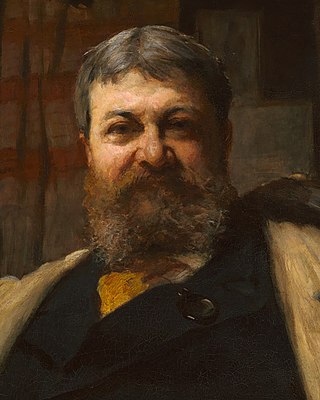
Henry Hobson Richardson, FAIA was an American architect, best known for his work in a style that became known as Richardsonian Romanesque. Along with Louis Sullivan and Frank Lloyd Wright, Richardson is one of "the recognized trinity of American architecture".

Calvert Vaux FAIA was an English-American architect and landscape designer, best known as the co-designer, along with his protégé and junior partner Frederick Law Olmsted, of what would become New York City's Central Park.

Andrew Jackson Downing was an American landscape designer, horticulturist, writer, prominent advocate of the Gothic Revival in the United States, and editor of The Horticulturist magazine (1846–1852). Downing is considered to be a founder of American landscape architecture.
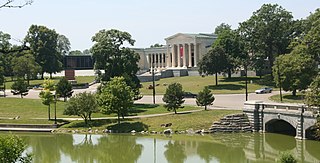
Delaware Park–Front Park System is a historic park system and national historic district in the northern and western sections of Buffalo in Erie County, New York. The park system was designed by Frederick Law Olmsted and Calvert Vaux and developed between 1868 and 1876.
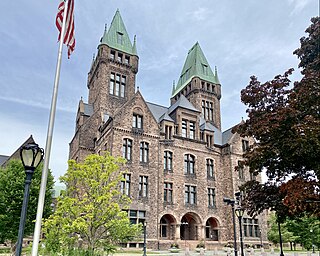
The Richardson Olmsted Complex in Buffalo, New York, United States, was designated a National Historic Landmark in 1986. The site was designed by the American architect Henry Hobson Richardson in concert with the landscape team of Frederick Law Olmsted, landscape architect of New York City's Central Park, and Calvert Vaux in the late 1800s, incorporating a system of treatment for people with mental illness developed by Thomas Story Kirkbride. Over the years, as mental health treatment changed and resources were diverted, the buildings and grounds began a slow deterioration. In 2006, the Richardson Center Corporation was formed to restore the buildings. The building was renovated and opened in 2023 at The Richardson Hotel.

Many of the public parks and parkways system of Buffalo, New York were originally designed by Frederick Law Olmsted and Calvert Vaux between 1868 and 1896. They were inspired in large part by the parkland, boulevards, and squares of Paris, France. They include the parks, parkways and circles within the Cazenovia Park–South Park System and Delaware Park–Front Park System, both listed on the National Register of Historic Places and maintained by the Buffalo Olmsted Parks Conservancy.

Jacob Wrey Mould was a British architect, illustrator, linguist and musician, noted for his contributions to the design and construction of New York City's Central Park. He was "instrumental" in bringing the British High Victorian style of architecture to the United States, and was a founding member of the American Institute of Architects.
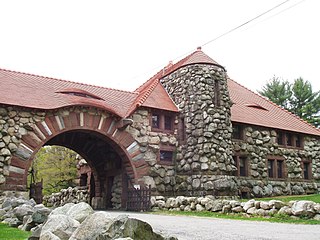
The Ames Gate Lodge is a celebrated work by American architect Henry Hobson Richardson. It is privately owned on an estate landscaped by Frederick Law Olmsted, but its north facade can be seen from the road at 135 Elm Street, North Easton, Massachusetts. In 2013, the Ames Gate Lodge was protected by a preservation easement held by Historic New England.

Hillside Cemetery is located on Mulberry Street in Middletown, New York, United States. Opened in 1861, it was designed in the rural cemetery style by Calvert Vaux and Frederick Law Olmsted, later noted for their collaboration on Central Park. There are several thousand graves, some with excellent examples of 19th-century funerary art.

The Riverside Historic District, also known as Riverside Landscape Architecture District, encompasses what is arguably one of the first planned suburbs in the United States. The district encompasses the majority of the village of Riverside, Illinois, a suburb just west of Chicago. It was planned and designed by Calvert Vaux and Frederick Law Olmsted and features a number of architecturally distinguished buildings.

Frederick Clarke Withers was an English architect in America, especially renowned for his Gothic Revival ecclesiastical designs. For portions of his professional career, he partnered with fellow immigrant Calvert Vaux; both worked in the office of Andrew Jackson Downing in Newburgh, New York, where they began their careers following Downing's accidental death. Withers greatly participated in the introduction of the High Victorian Gothic style to the United States.

The Former Administration Building of the Buffalo Psychiatric Center is the central building of the Richardson Olmsted Complex in Buffalo, New York.

Riverside Park is a historic park located in the Riverside neighborhood in Buffalo, New York. Located in northwest Buffalo, it is an individual park designed by the Olmsted Architectural Firm in 1898 after Frederick Law Olmsted's retirement. It is on a 22-acre (8.9 ha) site on a bluff overlooking the Niagara River. Riverside Park was designed for active recreation and periodic alterations have occurred as the community's recreation needs have changed. Despite the changes, the park retains numerous original design elements and remains as the final element completed as a part of the Olmsted plan for Buffalo's park system.
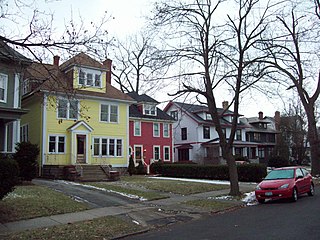
Parkside East Historic District is a national historic district located at Buffalo in Erie County, New York. The district is architecturally and historically significant for its association with the 1876 Parks and Parkways Plan for the city of Buffalo developed by Frederick Law Olmsted. It consists of 1,769 contributing structures developed from 1876 to 1936, as a middle class residential neighborhood. The district largely contains single-family dwellings, built in a variety of popular architectural styles, and located along the irregular and curvilinear street pattern developed by Olmsted. The district is located to the east of Buffalo's Delaware Park and includes the Walter V. Davidson House and the separately listed Darwin D. Martin House, both designed by Frank Lloyd Wright.

Martin Luther King Jr. Park, originally The Parade and after 1896, Humboldt Park, is a historic park located in Buffalo in Erie County, New York. The park is located in east Buffalo and bisected by Fillmore Avenue.
Cazenovia Park–South Park System is a historic park system located in the South Buffalo neighborhood at Buffalo in Erie County, New York. The interconnected set of parkways and parks was designed by Frederick Law Olmsted as part of his parks plan for the city of Buffalo, as inspired in large part by the parkland, boulevards, and squares of Paris, France.

The Architecture of Buffalo, New York, particularly the buildings constructed between the American Civil War and the Great Depression, is said to have created a new, distinctly American form of architecture and to have influenced design throughout the world.

The Halsey Stevens House is a historic house located at 182 Grand Street in Newburgh, New York. It is one of the first residences designed by the architects Calvert Vaux and Frederick Clarke Withers after the death of their mentor Andrew Jackson Downing the previous year. Listed as part of the Montgomery—Grand—Liberty Streets Historic District in Newburgh, the house has been well-preserved and demonstrates how both worked with Gothic Revival and Italianate styles. Halsey R. Stevens, their client, was a lumber dealer and Biblical scholar.

The Eugene A. Brewster House is a historic house located at 264 Grand Street in Newburgh, New York. Built in 1865, the year Newburgh incorporated as a city, it was designed by English immigrant architect Frederick Clarke Withers for attorney Eugene Augustus Brewster. It is the last residence Withers designed in Newburgh, where he began his career as a practicing architect in the mid-1850s.

















